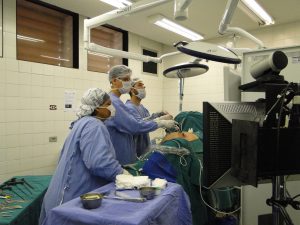*Name has been changed to protect the interviewer’s identity.
It was a tedious week for 55-year-old Youssef Ezzeldin as he searched for a vacant hospital bed for his son’s tonsillectomy. Eager to offer his 7-year-old a relaxed experience, he reluctantly refused to settle for a public hospital in spite of free treatment.
After countless calls and visits, Ezzeldin finally managed to book a surgery appointment through a relative who is a doctor at a private hospital in Heliopolis. State medical insurance covered two-thirds of the EGP 10,000 (about $600) cost.
Things got worse when Ezzeldin realized his older son needed treatment for bipolar disorder. For two months, his 26-year-old exhibited extremes in behavior and struggled to cope with routine daily tasks.
Cash-strapped, Ezzeldin scoured Cairo but was unable to find affordable shared accommodation at a private mental health hospital. He learned that a one-week stay would cost EGP 25,000. With an EGP 12,000 monthly salary from his job at a state oil and gas company, treatment is out of reach.
Stagnant salaries, rising costs, and insufficient reimbursement rates from insurers have made it increasingly difficult for middle-class Egyptians to afford proper health care.
Coverage plans often exclude primary care, mother and childcare, elderly care, psychiatric care, and addiction treatment. However, some multinationals began covering psychiatric treatment with private medical insurance, according to psychotherapist Yomna Zaki.
Ultimately, contributions by family members paid for Ezzeldin’s son’s treatment, a bill that totaled almost EGP 100,000 for a month stay at Al Mashfa Psychiatric Hospital on Cairo-Ismailia desert road.
“There was no other solution. My salary barely covers my family’s monthly expenses, and the only thing I could have afforded was treatment at a public hospital,” says Ezzeldin from his apartment in Nasr City. “There is no way I would let my son risk receiving substandard psychiatric help.”
The government estimates 30 percent of the population has enrolled in private health insurance plans, yet World Bank data shows Egyptians now pay out-of-pocket for nearly 60 percent of their health care expenses — $30.2 billion out of a total of $51.8 billion, according to the Institute for Health Metrics and Evaluation. These figures are a significant reason behind the government’s goal of providing universal health coverage by 2030.
Due to a rapidly growing population, insurance coverage put more pressure on an already strained private hospital infrastructure, says Bassel Essam, a professor of anesthesiology and intensive care and emergency at the Faculty of Medicine at Ain Shams University.

Making more beds
Global commercial real estate services provider Colliers International estimates that by next year Egypt needs 77,000 more hospital beds at the cost of $21 billion and another 178,000 by 2050 requiring a $40 billion to $60 billion investment.
Essam says the government’s new health care law is designed to encourage private-sector doctors and hospitals to provide affordable services as state-run facilities struggle to keep pace with demand. He believes investments should be directed toward increasing beds at accessible, affordable class B and C hospitals. “Money should not just be pumped into constructing seven-star-hotel-like hospital facilities and medical parks,” he says.
He further suggests that the government offer land and tax incentives for investments directed toward construction of the hospitals, which could partner with state medical insurance hospitals. That would help middle-income Egyptians find better access to affordable care.
Essam, who runs a privately owned intensive care unit (ICU) at Helmeyat Al Zaytoun, believes third party private insurance companies could help ease the registration process and long waiting periods, adding the government cannot do it alone.
He says many medical facilities, including his ICU, Einaya, have the potential and resources to operate at higher capacity in terms of bed availability and workforce. His ICU, however, is struggling to reach half its capacity of 15 fully-equipped beds because of its location in an impoverished neighborhood.
Launched in 2016 for EGP 2.7 million, the ICU was created to provide affordable, high-quality services. Einaya’s highest occupancy was six beds. Patients pay an average of EGP 4,000 per night.
“Realistically, none of the income brackets is comprehensively served by Egypt’s healthcare system,” he says. “The lower and higher classes are ill-served due to an insufficient number of beds at public and private hospitals, and the uninsured middle class can neither afford the out-of-pocket expenses demanded by private hospitals nor comfortably accept a level of overall care below their standards.”
Initiating partnerships with overcrowded public hospitals and private insurance companies to route patients to medical facilities like Einaya would be a win-win situation, says Essam.
Hossam El Ganzoury, chairman of El Ganzoury Specialized Hospitals in Heliopolis, shares Essam’s sentiments on the benefits of public-private partnerships. However, he sees Egypt as lagging in hospitals serving Egypt’s upper class, which is willing to pay or travel abroad for care.
“This group is not just looking for good medical care; it is looking for highly trained staff, communicative nurses, and an overall comfortable and luxurious experience,” he says.
Aiming to target this group, El Ganzoury in June unveiled an expansion of his general hospital, which was established in 1973. The old building was mainly serving class B and C patients, with 60-70 percent covered by health insurance.
The expansion adds 84 beds, eight operating theaters, 11 ICU beds, as well as pediatric facilities. Construction of the new facility started in 2003, says El Ganzoury, noting that licensing and legislative difficulties coupled with rising costs are the core challenges of investing in healthcare in Egypt. “To allow private healthcare services to grow and raise capital, we need to simplify and streamline the regulatory process and overcome bottlenecks in licensing,” he says.

Managing demand
Egypt’s health care system is composed of a variety of public and private entities. The primary government player is the Ministry of Health and Population, which directs policy and provides most services at free, public hospitals.
The country has 2,062 hospitals with about 131,000 beds, according to a 2017 report by Colliers International. Public facilities account for 75 percent of Egypt’s available hospital beds – 93,267 out of 124,361 in 2015, according to CAPMAS. That same year, the government paid EGP 4.5 million for public-care treatment.
In the current fiscal year, the government plans to spend EGP 2.1 billion on universal healthcare services. In May, Health Minister Hala Zaid asked the government to increase the budget allocation for the health sector to EGP 100 billion. To implement the Universal Healthcare Act, the ministry will require an additional EGP 33 billion for fiscal year 2019-2020, she said. The ministry previously asked for EGP 96 billion for healthcare during the next fiscal year, but the Finance Ministry has approved only EGP 73 billion.
Management of public hospitals is split between the Ministry of Higher Education, which oversees teaching hospitals such as Kasr Al Aini at Cairo University and Demerdash at Ain Shams University, and the Ministry of Social Affairs, which supervises religiously affiliated hospitals and other charitable organizations that provide health services.
The public and parastatal healthcare sector represent almost 57,000 beds and 268 hospitals in Egypt. The parastatal sector is run by the state but governed by its own set of rules and regulations, has separate budgets and exercises more autonomy in daily operations. The government sector provides an additional 41,000 beds, while the private sector supplies 33,000 beds in 1,400 hospitals.
The 2017 Colliers International report notes that with demand buoyed by a rapidly growing population, the country will need an additional 4.4 million square meters of hospital space and 2.7 million square meters of clinic space by 2025, with investments of EGP 40.5 billion and EGP 17.8 billion, respectively.
Ayman Saleh, director of Ain Shams Hospitals, believes the challenge for Egypt’s public hospitals involves a redistribution of resources to correct the discrepancy between the number of beds and manpower, not just adding more beds.
Demerdash, the university hospital system of Ain Shams, has a total of 4,000 beds in 12 hospitals and medical centers with more than 1.5 million patient visits per year, according to Saleh.
Places like Demerdash are where the middle class should be treated, says Saleh, yet that is not the case due to misconceptions about public healthcare providers.
Patients have every right to complain about overcrowding, slothful service, inadequate communication skills, and rude staff, he says, but it does not mean Demerdash can’t be used by middle-income individuals. “It just means it might take some more time and patience for customers to get the care they deserve.”
A new nonprofit initiative began at Demerdash hospitals in 2016 that offers discounts for Egyptians who can pay their expenses. The low-cost treatment units offer many surgical procedures at half the price of other upmarket facilities. A cardiac catheterization procedure costs EGP 2,000, compared to EGP 6,000. More advanced procedures like a coronary stent placement would cost EGP 18,000 at the new unit, compared to about EGP 35,000 at private hospitals.
Fees paid by patients go toward the renovation of Demerdash’s free care facilities.
However, Saleh says the number of patients utilizing the new unit is not as high as it might be due to inefficient marketing. Economy treatment accounts for 150,000 patients out of Demerdash’s 1.5 million annually.
Many units lack privacy in post-surgery recovery rooms, a disturbing factor for some people. Omar El Tahawy, a 34-year-old computer engineer who sought treatment at Demerdash’s new unit for a sleeve gastrectomy, was directed to a room with other patients after his procedure. The operation cost EGP 20,000 instead of about EGP 100,000 at a private hospital.
“I can’t say the doctors were bad, the procedure was smooth, the place was clean, and the facility is very well-equipped, but in the end, you get what you pay for,” says El Tahawy.
Saleh, Ain Shams’ director, says Demerdash offers a high standard of care with up-to-date equipment. However, there is a lack of specialists and highly trained nurses outside Cairo and Alexandria. “If I do not have those specializations available in all hospitals, then I don’t have sufficient manpower to use those beds,” he says. “They’re good for nothing.”
Moreover, Saleh says that recruiting foreign personnel has been even more challenging since the devaluation of the pound. “Before the devaluation, we were bringing in some nurses from abroad,” he says. “But afterward, salaries for foreign staff are very high. Average international salaries are about $1,000 per month, often making them three times more expensive than Egyptian nurses.”
He also cites a lack of physicians in rural areas. Latest data from the World Bank says Egypt has 0.81 physicians per 1,000 people, compared to 2.65 per 1,000 in Jordan, 1.75 in Turkey and 1.56 in UAE.

Room for investors
The public healthcare sector’s struggle to meet quality expectations of middle-income Egyptians and a surging population has created an opportunity for providers of commercial clinical services. Individual investors are seeking to profit from this gap and secure guaranteed returns.
Egypt and similar countries are attractive since they are relatively unexploited by investors introducing novel revenue-generating concepts, says Hassan Fikry, head of investor relations at Cleopatra Hospitals Group (CHG).
CHG has invested nearly EGP 600 million over the past three years in its existing hospitals. Within the next two years, the company plans to invest EGP 1.5 billion to double the number of hospital rooms to 1,200 and open two polyclinic facilities with primary care doctors and specialists yearly by 2023.
While the group’s strategy is to provide healthcare for higher-income patients, he says, “due to the penetration of private insurance, we now actually see all segments of society,” It serves about 1 million patients per year.
Fikry sees more room for improvement. He believes the Universal Healthcare Act will overcome concerns and glitches and offer better medical services to all. “Public facilities need a push in standard operating procedures, efficiency training, and operating structures,” Fikry explains.
To target this limitation, the Ministry of Health in April signed agreements with a number of private hospitals participating in the new healthcare system, including CHG, Dar Al Fouad, Al Salam and Maghrabi hospitals to train medical and administrative staff at several Port Said hospitals, where the first phase of the universal healthcare act is being rolled out.
The partnership program aims to improve the effectiveness of medical and non-medical staff, according to CHG Project Manager Abdelrahman ElMazny. CHG offers training on supply chain management, marketing, and human resources. CHG is working at three hospitals in Port Said, including El Nasr Specialized Hospital for children and Tadamon General Hospital.
“We are trying to develop their personnel so patients can receive an experience similar to that at private hospitals,” says ElMazny. To date, CHG has trained more than 500 employees on patient handling and communication. The group also is collaborating with Port Said’s hospital staff.
Eventually, says ElMazny, there will be a chance to close the gap between private and public facilities so all Egyptians can receive quality healthcare.







